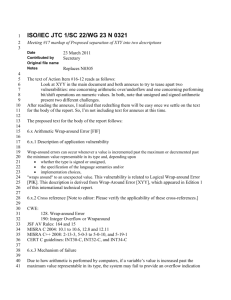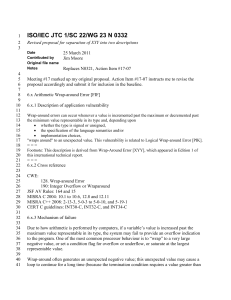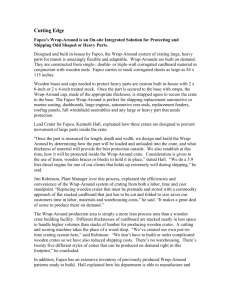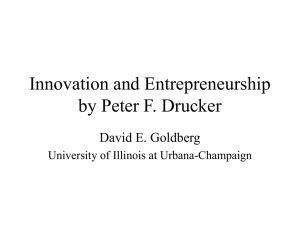n0305 - IEEE Standards Working Group Areas
advertisement
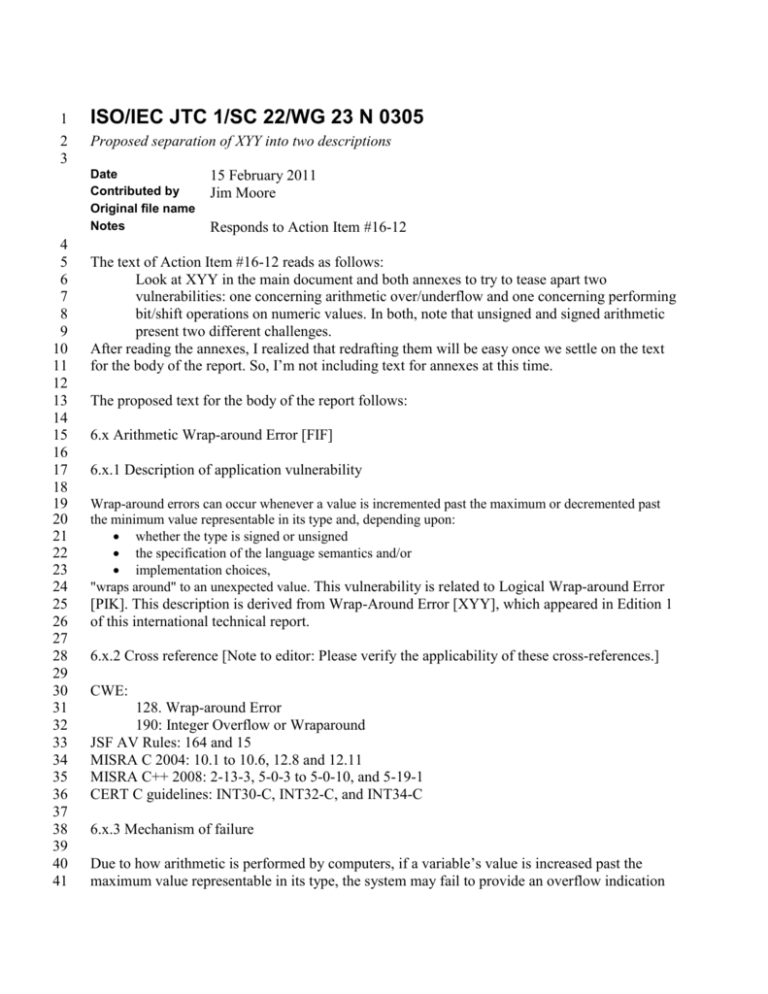
1 2 3 ISO/IEC JTC 1/SC 22/WG 23 N 0305 Proposed separation of XYY into two descriptions Date Contributed by Original file name Notes 4 5 6 7 8 9 10 11 12 13 14 15 16 17 18 19 20 21 22 23 24 25 26 27 28 29 30 31 32 33 34 35 36 37 38 39 40 41 15 February 2011 Jim Moore Responds to Action Item #16-12 The text of Action Item #16-12 reads as follows: Look at XYY in the main document and both annexes to try to tease apart two vulnerabilities: one concerning arithmetic over/underflow and one concerning performing bit/shift operations on numeric values. In both, note that unsigned and signed arithmetic present two different challenges. After reading the annexes, I realized that redrafting them will be easy once we settle on the text for the body of the report. So, I’m not including text for annexes at this time. The proposed text for the body of the report follows: 6.x Arithmetic Wrap-around Error [FIF] 6.x.1 Description of application vulnerability Wrap-around errors can occur whenever a value is incremented past the maximum or decremented past the minimum value representable in its type and, depending upon: whether the type is signed or unsigned the specification of the language semantics and/or implementation choices, "wraps around" to an unexpected value. This vulnerability is related to Logical Wrap-around Error [PIK]. This description is derived from Wrap-Around Error [XYY], which appeared in Edition 1 of this international technical report. 6.x.2 Cross reference [Note to editor: Please verify the applicability of these cross-references.] CWE: 128. Wrap-around Error 190: Integer Overflow or Wraparound JSF AV Rules: 164 and 15 MISRA C 2004: 10.1 to 10.6, 12.8 and 12.11 MISRA C++ 2008: 2-13-3, 5-0-3 to 5-0-10, and 5-19-1 CERT C guidelines: INT30-C, INT32-C, and INT34-C 6.x.3 Mechanism of failure Due to how arithmetic is performed by computers, if a variable’s value is increased past the maximum value representable in its type, the system may fail to provide an overflow indication 42 43 44 45 46 47 48 49 50 51 52 53 54 55 56 57 58 59 60 61 62 63 64 65 66 67 68 69 70 71 72 73 74 75 76 77 78 79 80 81 82 83 84 85 86 to the program. One of the most common processor behaviour is to “wrap” to a very large negative value, or set a condition flag for overflow or underflow, or saturate at the largest representable value. Wrap-around often generates an unexpected negative value; this unexpected value may cause a loop to continue for a long time (because the termination condition requires a value greater than some positive value) or an array bounds violation. A wrap-around can sometimes trigger buffer overflows that can be used to execute arbitrary code. It should be noted that the precise consequences of wrap-around differ depending on: Whether the type is signed or unsigned Whether the type is a modulus type Whether the type’s range is violated by exceeding the maximum representable value or falling short of the minimum representable value The semantics of the language specification Implementation decisions However, in all cases, the resulting problem is that the value yielded by the computation may be unexpected. 6.x.4 Applicable language characteristics This vulnerability description is intended to be applicable to languages with the following characteristics: Languages that do not trigger an exception condition when a wrap-around error occurs. 6.x.4 Avoiding the vulnerability or mitigating its effects Software developers can avoid the vulnerability or mitigate its ill effects in the following ways: Determine applicable upper and lower bounds for the range of all variables and use language mechanisms or static analysis to determine that values are confined to the proper range. Analyze the software using static analysis looking for unexpected consequences of arithmetic operations. 6.x.6 Implications for standardization In future standardization activities, the following items should be considered: Language standards developers should consider providing facilities to specify either an error, a saturated value, or a modulo result when numeric overflow occurs. Ideally, the selection among these alternatives could be made by the programmer. 6.y Logical Wrap-around Error [PIK] 6.y.1 Description of application vulnerability 87 88 89 90 91 92 93 94 95 96 97 98 99 100 101 102 103 104 105 106 107 108 109 110 111 112 113 114 115 116 117 118 119 120 121 122 123 124 125 126 127 128 129 130 131 132 Using shift operations as a surrogate for multiply or divide may produce an unexpected value when significant bits are lost. This vulnerability is related to Arithmetic Wrap-around Error [FIF]. This description is derived from Wrap-Around Error [XYY], which appeared in Edition 1 of this international technical report. 6.x.2 Cross reference [Note to editor: Please verify the applicability of these items.] CWE: 128. Wrap-around Error 190: Integer Overflow or Wraparound JSF AV Rules: 164 and 15 MISRA C 2004: 10.1 to 10.6, 12.8 and 12.11 MISRA C++ 2008: 2-13-3, 5-0-3 to 5-0-10, and 5-19-1 CERT C guidelines: INT30-C, INT32-C, and INT34-C 6.y.3 Mechanism of failure Coders sometimes use shift operations with the intention of producing results equivalent to multiplying by a power of two or dividing by a power of two. However, errors can result from this practice. For example, if the programmer mistakenly uses logical shifts on signed arithmetic values, the results may test correctly for small values but produce unexpected results when used with large values. The problem, of course, is that the sign bit can be shifted out of the value converting a negative value into a positive one or vice versa. Even when the correct type of shift is coded, there can still be problems with unexpected and undetected numerical underflow or overflow if significant bits are shifted out of the value. Stated most generally, replacing multiply and divide operations with shifting operations requires detailed knowledge of the representation of the values across the varieties of processors on which the code may be used. In addition, it requires detailed analysis of the range of values for which the shift operations will produce valid results and checking (or static analysis) to ensure that the values never go outside of the range. Wrap-around often generates an unexpected negative value; this unexpected value may cause a loop to continue for a long time (because the termination condition requires a value greater than some positive value) or an array bounds violation. A wrap-around can sometimes trigger buffer overflows that can be used to execute arbitrary code. 6.y.4 Applicable language characteristics This vulnerability description is intended to be applicable to languages with the following characteristics: Languages that do not trigger an exception condition when a wrap-around error occurs. Languages that do not fully specify the distinction between arithmetic and logical shifts. 6.y.4 Avoiding the vulnerability or mitigating its effects 133 134 135 136 137 138 139 140 141 142 143 144 145 146 147 148 149 Software developers can avoid the vulnerability or mitigate its ill effects in the following ways: Determine applicable upper and lower bounds for the range of all variables and use language mechanisms or static analysis to determine that values are confined to the proper range. Analyze the software using static analysis looking for unexpected consequences of shift operations. Avoid using shift operations as a surrogate for multiplication and division. Most compilers will use the correct operation in the appropriate fashion when it is applicable. 6.y.6 Implications for standardization In future standardization activities, the following items should be considered: Language standards developers should consider providing facilities to specify either an error, a saturated value, or a modulo result when logical overflow occurs. Ideally, the selection among these alternatives could be made by the programmer.
